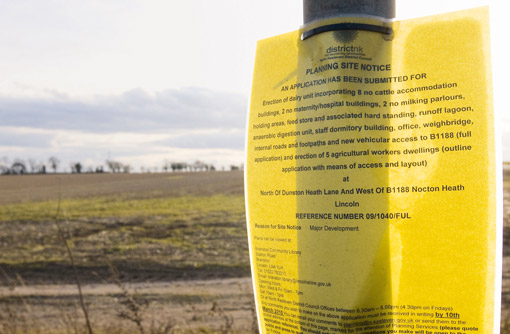Top tips to getting your planning permission accepted

Getting planning permission for renewable energy can be a bit of a headache. David Collier, NFU’s chief rural affairs adviser, shares some top tips.
There may be uncertainty over the government’s policies on renewable energy, but much of the best practice on seeking planning permission is unchanged.
In the first instance it makes sense to consider doing a strategic review of the business to decide whether renewable energy should feature at all over the next few years. A proper, informed review is very important. This will ensure the situation is optimised and you do not do something that will prejudice a better project in the future.
Site assessment
Location is also important and understanding a site and its constraints allows you to put the right technology in the right place. When you don’t have a site that’s suitable, the right advice may be “don’t apply”.
Site suitability depends on a number of factors, and the key considerations will vary with the technology. For wind turbines, visual impact and noise are likely to be uppermost, whereas for anaerobic digesters odour, highways and visual impact may be the key concerns.
And there are some land areas that may need to be avoided. It’s important to account for boundary maintenance or sterile strips caused by water or gas mains, for example.
When there seems to be a suitable site, there are other tasks to complete before a planning application is even considered. It’s important to agree arrangements for supplying electricity to the grid. Before considering planning permission, ensure distribution network operator (DNO) consents are sorted out.
It is also advisable to check whether planning permission is required. If it is possible the project will fit under permitted development rights, then tailoring a project may save huge amounts of time, cost and effort.
Next steps
Having established that a renewables project is a runner, and that planning permission is needed, is this the time to apply? The answer is probably no, as it’s still too soon.
Pre-application discussions with the local planning authority can be vital. They can establish the council’s key concerns (and hence the parts of the application in which they will be most interested), identify the need for reports and studies, and whether an environmental impact assessment will be needed.
All councils ask for slightly different details, so for a small wind turbine some want noise monitoring, landscape impact assessments, bat surveys and so on, while others don’t. This will take more time and cost more initially, but will avoid delays during the process.
Sometimes planning officers are unfamiliar with the technology being proposed, so providing a technical briefing note can pay dividends. It is also worth researching how other applications for similar proposals have fared. Lessons can be learned whether or not they were successful.
Speaking to neighbours is another vital, early step in the process. Other consultees will depend on circumstances, but they may include the parish council, the British Horse Society, officers for an Area of Outstanding Natural Beauty, and wildlife groups.
These consultations may result in pressure to rethink the location of the equipment, and it may be better to alter plans now than face the prospect of refusal and an appeal. Landscaping may help, but it needs to be effective without hindering the efficiency of the operation. With ground-mounted solar, landscaping the edge of the site without causing shadowing is important.
Submitting an application
Much of the hard work has now been done, and provided it has been successful, the chances of approval should be good. Mentioning supportive planning policies – such as the National Planning Policy Framework – should help, and an artist’s impression may allay fears about the visual impact. Other supporting information will depend on circumstances. Any lobbying should be done sensitively – overkill can alienate elected members.
Read more dairy news
